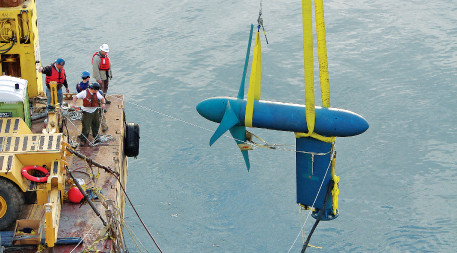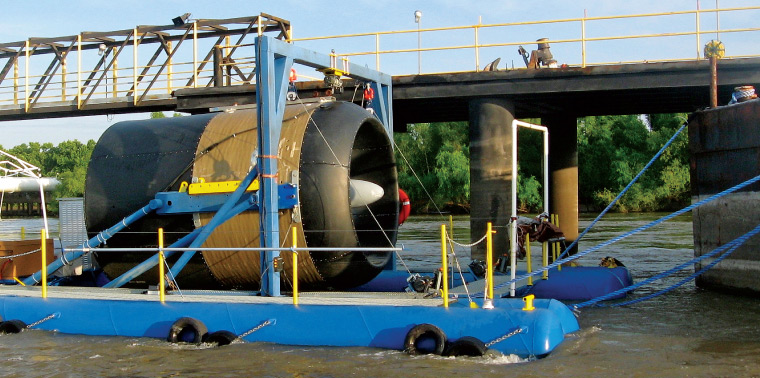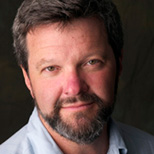As of August 2012, FERC had issued 113 “preliminary” marine and hydrokinetic permits. Another 62 projects were in the “prefiling” license phase, many involving proposals on the Mississippi and other midwestern rivers filed by Free Flow Power and other energy companies.
Near Roosevelt Island in New York City, Verdant’s project is the first to receive a commercial license from FERC to produce tidal power. The turbines stand on pier-postlike structures drilled into bedrock in the east channel — the west channel handles all the shipping traffic. Located 6 to 8 feet below the river’s surface, the turbines turn at 35 revolutions per minute and change direction, like a weather vane, as the tide turns. Eventually the project will produce 1 MW of power, says Taylor, but the real opportunity “is 1,000 MW, for the Hudson River, Long Island Sound and upstate using this type of resource.”

This turbine was installed in New York City’s East River in 2006 as part of the Roosevelt Island Tidal Energy Project — the first licensed commercial tidal power project in the U.S. Photo by Kris Unger/Verdant Power, Inc.
A different sort of hydrokinetic turbine is being tested in the Mississippi by Free Flow Power, which has proposed 65 marine hydrokinetic projects totaling 4 gigawatts. Free Flow’s innovation, which looks like a jet turbine and is at least 6 feet tall, captures energy as current flows through it at a nominal pace of 32 rpm, says Jon Guidroz, Free Flow’s project development director.
That requires the river to flow 7.2 feet per second, a speed capable of allowing the turbines to produce 40 kW, much less than traditional dam turbines. The idea, says Guidroz, is to install 5 to 10 MW of turbines per mile using a configuration of six turbines set up on pilings. Sets of turbines at 90-foot intervals could be put into place, ideally, in the southern section of the Mississippi where the river reaches a mile wide and more than 100 feet deep. Before long various stretches of the river would have the equivalent of an underwater wind farm, he suggests.
“When I think of hydro I think about community development. Anywhere in the world where you install hydro you will be building a community.” – Nelson Energy manager Bob Larson
In 2011 Free Flow tested a hydrokinetic turbine attached to a dock on the Mississippi in Louisiana owned by Dow Chemical Company. Engineers studied the energy generation level and ability of the turbine to withstand the rigors of a river often filled by branches, muck and other debris.
“We saw it perform in a real river environment and it was successful. We’re pleased with the power generation it produces,” Guidroz says.
Hydrokinetic experiments, however, have not always worked. HGE started testing a hydrokinetic turbine on a Mississippi lock and dam in Hastings, Minn., in 2009. Mark Stover, vice president of corporate affairs, says the turbine created power but wasn’t ready for prime time, forcing HGE to focus on a modular “plug and play” turbine it developed for locks and dams. That turbine can be installed next to a dam or downstream from it using an approach requiring less construction than a typical project.
“We were able to take the technology and development approach [at Hastings] and plug that into our low-head technology,” Stover says. “I’m not sure if we had not done Hastings that we would have seen the light on low head. There is a ton of potential low-head hydro in the United States that has not been developed for 20 or 30 years, and we’re going to go after it.”
A self-described “optimistic curmudgeon,” Nelson Energy manager Bob Larson sees hydro as a beneficial not only to energy balances but also to the economy as a whole. He notes that Minneapolis became a vibrant metropolis thanks to St. Anthony Falls, which was diverted in the 1800s to run sawmills and flour mills that produced the city’s original wealth.
“We’ve been a growing community for a long time because of hydro,” he says. “When I think of hydro I think about community development. Anywhere in the world where you install hydro you will be building a community.”
![]()
A version of this feature originally appeared in the Fall 2012 issue of Momentum magazine, Ensia’s predecessor.
Ensia shares solutions-focused stories free of charge through our online magazine and partner media. That means audiences around the world have ready access to stories that can — and do — help them shape a better future. If you value our work, please show your support today.
Yes, I'll support Ensia!
